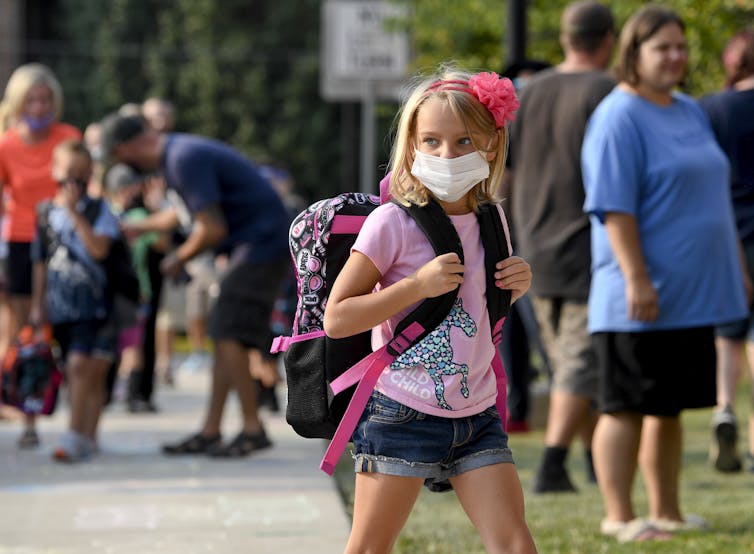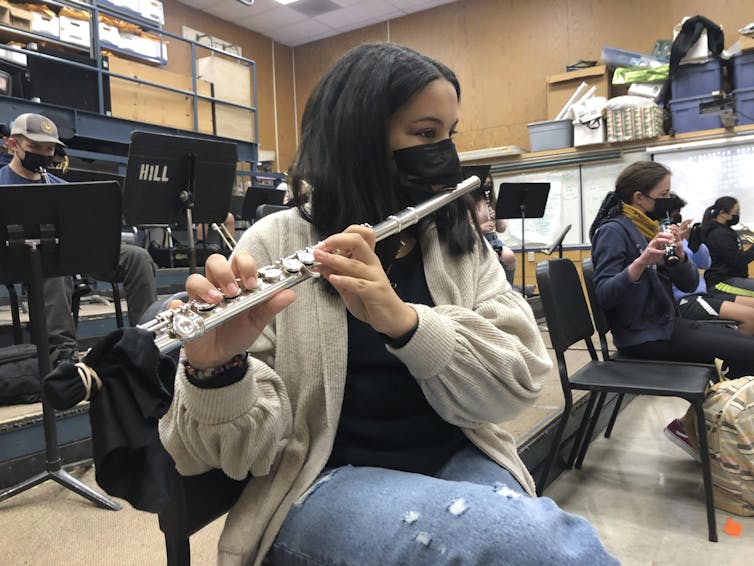When can kids get the COVID-19 vaccine? A pediatrician answers 5 questions parents are asking
- Written by James B. Wood, Assistant Professor of Clinical Pediatrics, Indiana University School of Medicine
A big question among parents and teachers right now is whether their kids will be vaccinated against COVID-19 in time for the fall school semester. Some have wondered whether the vaccine is even necessary for children. Dr. James Wood[1], a pediatrician and assistant professor of pediatric infectious diseases, explains what doctors know today about the risk children face of getting and spreading the coronavirus and when vaccines might be available.
Do kids really need to get the COVID-19 vaccine?
The short answer is yes. A lot of studies have shown that COVID-19 isn’t as severe in children[2], particularly younger kids – but that doesn’t mean kids aren’t at risk of getting infected and potentially spreading the virus[3].
Children under 12 who get COVID-19 do tend to have mild illnesses or no symptoms, while teenagers seem to have responses somewhere between what adults and younger kids have experienced. The Centers for Disease Control and Prevention found that teens were about twice as likely[4] to be diagnosed with COVID-19 as children ages 5-11.
Researchers are still trying to understand why we’re seeing these differences between older and younger kids. Behavior probably plays a part. Teenagers are more likely to engage in social or group activities, and they and may or may not be wearing masks. Immune differences[5] and biologic factors[6] may also play a role. Non-SARS-CoV-2 coronaviruses are common in children[7], often resulting in upper respiratory infection. Is their frequent exposure to other coronaviruses helping protect them from severe COVID-19? That is one hypothesis. We know younger kids’ immune responses in general are different from adults, and likely play a role in protection.
It’s important to remember that while most children get only mild symptoms, they still face risks. At least 226 U.S. children[8] with COVID-19 have died, and thousands have been hospitalized[9].
The key to minimizing the risk is to make sure kids eventually get vaccinated, follow social distancing recommendations and wear masks.
Are kids spreading the virus?
In a setting like a school where mask-wearing and social distancing are enforced, young kids seem to not spread the virus very much when the rules and guidelines are being followed. One CDC review found little difference in community cases[10] in counties with elementary schools open and those with remote learning.
If precautions aren’t being taken, children infected with the coronavirus very well could spread it to adults[11]. What isn’t clear yet is how great that risk is.
 In school settings, younger children have been less likely to spread the virus to adults.
Ben Hasty/MediaNews Group/Reading Eagle via Getty Images[12]
In school settings, younger children have been less likely to spread the virus to adults.
Ben Hasty/MediaNews Group/Reading Eagle via Getty Images[12]
To keep schools as safe as possible, continuing schoolwide mask and social distancing policies will be important. With teenagers in particular, mask rules can’t hinge on whether the person has been vaccinated or not. Until herd immunity[13] within the whole community is at a good level, social distancing and masking is still going to be the recommendation.
So, when can kids get vaccinated?
Right now, the Pfizer vaccine is the only one in the U.S. authorized for teenagers as young as 16[14]. Before kids under 16 can be vaccinated, clinical trials need to be completed in thousands of young volunteers to assess the vaccines’ safety and efficacy.
Vaccine manufacturers Moderna[15] and Pfizer[16] both have trials underway with adolescents[17] and expect to have data by late spring or early summer. If their vaccines are shown to be safe and effective, kids 12 and up could be vaccinated before school starts in the fall.
Realistically, young children probably won’t be eligible for the vaccine until late fall or winter at the earliest. Moderna just announced on March 16 that it has started testing the vaccine in children ages 6 months to 11 years[18]. Pfizer hasn’t reached that stage yet, and these trials take time.
What’s different about the vaccines kids will get?
The composition of the COVID-19 vaccines for children is the same as used in adults – the difference is that children may require a different dose.
The first step in vaccine trials is to figure out the right dose. The companies want to find the lowest possible dose that is both safe and produces a target level of antibodies. For example, Moderna uses a 100-microgram dose in adults. It is testing three different doses for children under age 2 – 25, 50 and 100 micrograms – and two doses for children over age 2, at 50 and 100 micrograms.
Once the company determines the optimal dose, it will launch a placebo-controlled trial to test its effectiveness, in which some children will get a placebo and some will get the vaccine.
 Students are now seated farther apart in many schools. The CDC recently changed its recommendation from 6 feet between children in K-12 schools to 3 feet unless the community has a high rate of viral spread.
AP Photo/Haven Daily[19]
Students are now seated farther apart in many schools. The CDC recently changed its recommendation from 6 feet between children in K-12 schools to 3 feet unless the community has a high rate of viral spread.
AP Photo/Haven Daily[19]
A rigorous system for pediatric vaccine trials is well established[20] in the U.S. These trials are key to assessing the safety and efficacy of vaccines in children, which can differ from adults.
I am optimistic that a safe and effective vaccine will be available for children. Thus far, there have not been any safety signals from either the adult or adolescent studies that have been worrying to me as a pediatrician, but the studies still need to be done in children.
How can parents create safe playdates for kids?
When I talk to parents, I explain that it’s a risk-versus-benefit question. Each family has a different tolerance.
From a medical standpoint, the mental health of kids and having them play with other kids is an important part of childhood.
[Over 100,000 readers rely on The Conversation’s newsletter to understand the world. Sign up today[21].]
I would say that unvaccinated kids playing indoors without masks on is still not a great idea. The risk is just too high at this point. As weather warms up, I would encourage kids to play outside. Ride bikes, play and socialize – just do it in a safe manner.
We all have pandemic fatigue, including medical professionals. As the weather gets warmer, I think everyone just wants to get back to normal. The worst thing we can do, right as we start to see a light at the end[22], is fall backward again – because that would just make it that much longer for everyone.
References
- ^ Dr. James Wood (news.iu.edu)
- ^ isn’t as severe in children (www.cdc.gov)
- ^ spreading the virus (doi.org)
- ^ teens were about twice as likely (www.cdc.gov)
- ^ Immune differences (doi.org)
- ^ biologic factors (jamanetwork.com)
- ^ common in children (doi.org)
- ^ 226 U.S. children (www.cdc.gov)
- ^ thousands have been hospitalized (services.aap.org)
- ^ little difference in community cases (www.cdc.gov)
- ^ spread it to adults (www.cidrap.umn.edu)
- ^ Ben Hasty/MediaNews Group/Reading Eagle via Getty Images (www.gettyimages.com)
- ^ herd immunity (www.nature.com)
- ^ as young as 16 (www.fda.gov)
- ^ Moderna (www.cdc.gov)
- ^ Pfizer (www.cdc.gov)
- ^ trials underway with adolescents (clinicaltrials.gov)
- ^ in children ages 6 months to 11 years (investors.modernatx.com)
- ^ AP Photo/Haven Daily (newsroom.ap.org)
- ^ well established (doi.org)
- ^ Sign up today (theconversation.com)
- ^ start to see a light at the end (covid.cdc.gov)
Authors: James B. Wood, Assistant Professor of Clinical Pediatrics, Indiana University School of Medicine

